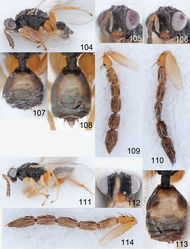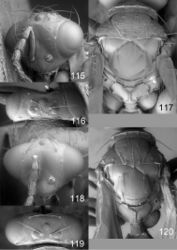Euplectrus daveroubiki
| Notice: | This page is derived from the original publication listed below, whose author(s) should always be credited. Further contributors may edit and improve the content of this page and, consequently, need to be credited as well (see page history). Any assessment of factual correctness requires a careful review of the original article as well as of subsequent contributions.
If you are uncertain whether your planned contribution is correct or not, we suggest that you use the associated discussion page instead of editing the page directly. This page should be cited as follows (rationale):
Citation formats to copy and paste
BibTeX: @article{Hansson2015ZooKeys, RIS/ Endnote: TY - JOUR Wikipedia/ Citizendium: <ref name="Hansson2015ZooKeys">{{Citation See also the citation download page at the journal. |
Ordo: Hymenoptera
Familia: Eulophidae
Genus: Euplectrus
Name
Euplectrus daveroubiki Hansson sp. n. – Wikispecies link – ZooBank link – Pensoft Profile
Material
Holotype a female labeled “COSTA RICA: Guanacaste, ACG, Sector Del Oro, Rio Chon, 6.i.2008, R. Moraga, ex Hemiceras vecina eating Inga oerstediana, sibling of wasp DHJPAR0023280, 08-SRNP-20135” (BMNH). PARATYPES: 8♀: COSTA RICA (ACG): Guanacaste: 3♀ with same label data as holotype (BMNH, INBio); 4♀ with same data as holotype but sibling of wasp DHJPAR0023278, 08-SRNP-20132 (CNC, MZLU, USNM); Sector Brasilia, Piedrona, 24.vi.2008, D. Briceno, ex Hemiceras nigrescens eating Inga oerstediana, sibling of wasp DHJPAR0031185, 08-SRNP-65614 (1♀, in BMNH).
Diagnosis
Lower face with median part yellowish-brown, pale area reaching to outer lateral margins of toruli (Fig. 112); fore and mid coxa yellowish-white, remaining parts of fore and mid legs and entire hind leg yellowish-brown (Fig. 111); scutellum 0.9× as long as wide with rather strong reticulation (Fig. 120); dorsellum with a very narrow groove along anterior margin (Fig. 748); median carina on propodeum narrow (Fig. 748); petiole 1.0× as long as wide; gaster dark brown, anterior ½ with a large yellowish-brown ±T-shaped spot (Fig. 113), and with tergites 5–6 reddish-brown posteromedially.
Description
Female. Length of body 2.5 mm. Antenna with scape yellowish-white in basal ½ and yellowish-brown in apical ½, pedicel yellowish-brown, flagellomere 1 dark brown with ventral part yellowish-brown, 2–6 dark brown (Fig. 114). Mandibles and palpi white. Head black and shiny, lower face with median part yellowish-brown, pale area reaching to outer lateral margins of toruli, with parts between pale area and eyes black (Fig. 112). Frons close to eyes with one row of setae (Fig. 118). Vertex with very weak reticulation (Fig. 119). Occipital margin with a weak carina (Fig. 119).
Mesosoma black and shiny (Fig. 111). Each sidelobe of mesoscutum with 12 setae. Scutellum 0.9× as long as wide; with rather strong reticulation, meshes slightly elongate (Fig. 120). Dorsellum with a very narrow groove along anterior margin (Fig. 748), medially less than 0.1× as long as length of dorsellum. Propodeum smooth (Fig. 748); anteromedially with a short triangular cup, 0.3× as long as wide; propodeal callus with nine setae. Legs (Fig. 111): fore and mid coxae yellowish-white, remaining parts of fore and mid legs and entire hind leg yellowish-brown. Fore wing: costal cell with one row of setae on ventral surface, and margin with one seta close to marginal vein; with 15 admarginal setae, in one row.
Gaster dark brown, anterior ½ with a large yellowish-brown ±T-shaped spot (Fig. 113), and with tergites 5–6 reddish-brown posteromedially.
Ratios. HE/MS/WM = 2.3/1.0/1.3; POL/OOL/POO = 6.8/4.2/1.0; OOL/DO = 1.2; WE/WF/WH/HH = 1.0/2.5/4.5/3.3; WH/WT = 1.0; PM/ST = 2.3; TS1/TS2/LT/LT1/LT2/LT3/LT4 = 3.7/2.3/6.6/2.3/1.7/1.0/4.6; LP/WP = 1.0; MM/LG = 1.3.
Male. Unknown.
Hosts and biology
Feeding on third instar larvae of Hemiceras vecina and Hemiceras nigrescens (Notodontidae) feeding on Inga oerstediana (Fabaceae), parasitoid cocoons stuck to dead larva and substrate.
Distribution
Costa Rica (Guanacaste Province).
Etymology
This species is named after Dave W. Roubik, in recognition of his contribution to the understanding of ACG Hymenoptera taxonomy.
Remarks
In the analyzed material there are three females, not included here, from same locality and host as holotype but collected 23.xii.2007 (sibling of wasp DHJPAR0038555, 07-SRNP-24811). These specimens appear similar to Euplectrus daveroubiki, but the barcode is different from other samples of Euplectrus daveroubiki (Suppl. material 1, sample called E. Hansson32). All three specimens are damaged and because of this the morphological analysis can not be done with sufficient accuracy. Therefore we leave these specimens untreated for now, but in the future, as more material becomes available, this puzzle will be dealt with.
Another puzzle associated with the samples assigned to this species concern samples DHJPAR0031185 and DHJPAR0023280. Specimens from DHJPAR0031185 and DHJPAR0023280 are morphologically identical and have a similar biology (both target Hemiceras spp.), but with different barcodes (Suppl. material 1). Since the morphology and biology is the same we prefer to treat these as the same species.
See also remarks under Euplectrus roysnellingi.
Original Description
- Hansson, C; Smith, M; Janzen, D; Hallwachs, W; 2015: Integrative taxonomy of New World Euplectrus Westwood (Hymenoptera, Eulophidae), with focus on 55 new species from Area de Conservación Guanacaste, northwestern Costa Rica ZooKeys, (485): 1-236. doi
Images
|


